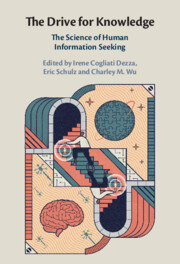Book contents
- The Drive for Knowledge
- The Drive for Knowledge
- Copyright page
- Contents
- Figures
- Tables
- Notes on Contributors
- Preface
- Part I What Drives Humans to Seek Information?
- Chapter 1 The Motivational Processes of Sense-Making
- Chapter 2 From Curiosity to Interest
- Chapter 3 Curiosity-Driven Exploration
- Chapter 4 Searching for Information, from Infancy to Adolescence
- Part II How Do Humans Search for Information?
- Part III Which Machinery Supports the Drive for Knowledge?
- Index
- References
Chapter 1 - The Motivational Processes of Sense-Making
from Part I - What Drives Humans to Seek Information?
Published online by Cambridge University Press: 19 May 2022
- The Drive for Knowledge
- The Drive for Knowledge
- Copyright page
- Contents
- Figures
- Tables
- Notes on Contributors
- Preface
- Part I What Drives Humans to Seek Information?
- Chapter 1 The Motivational Processes of Sense-Making
- Chapter 2 From Curiosity to Interest
- Chapter 3 Curiosity-Driven Exploration
- Chapter 4 Searching for Information, from Infancy to Adolescence
- Part II How Do Humans Search for Information?
- Part III Which Machinery Supports the Drive for Knowledge?
- Index
- References
Summary
In this chapter we discuss the psychological function of “the drive for sense-making,” or our innate desire to make sense of the world. We start by discussing why sense-making generates a drive, similar to those associated with the primary reinforcers of food, water, sleep, sex, shelter, and air. In our account, the drive for sense-making fills a critical gap in purely goal-oriented cognition by motivating us to continue investing in knowledge even when we cannot foresee exactly how it will benefit us. We then examine three different factors that shape the particular form sense-making takes: (1) the practical utility of holding accurate beliefs for attaining concrete goals, (2) the motivational significance of some beliefs, which generates a desire to make sense of the world in a way that feels good, and (3) the impact of computational limitations on the sense-making process, especially our limited ability to explicitly predict what information will turn out to be useful. Finally, we turn our attention to how these factors help to explain aberrant sense-making phenomena such as conspiracy theories, science denial, and political polarization.
Information
- Type
- Chapter
- Information
- The Drive for KnowledgeThe Science of Human Information Seeking, pp. 3 - 30Publisher: Cambridge University PressPrint publication year: 2022
References
Accessibility standard: Unknown
Why this information is here
This section outlines the accessibility features of this content - including support for screen readers, full keyboard navigation and high-contrast display options. This may not be relevant for you.Accessibility Information
- 5
- Cited by
